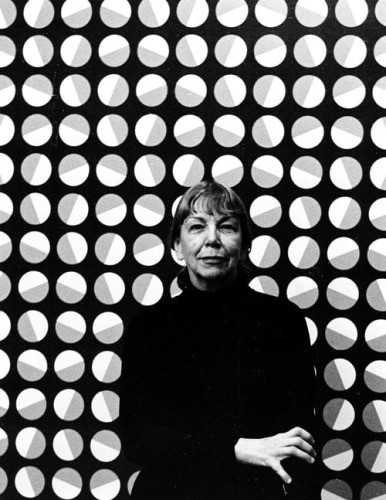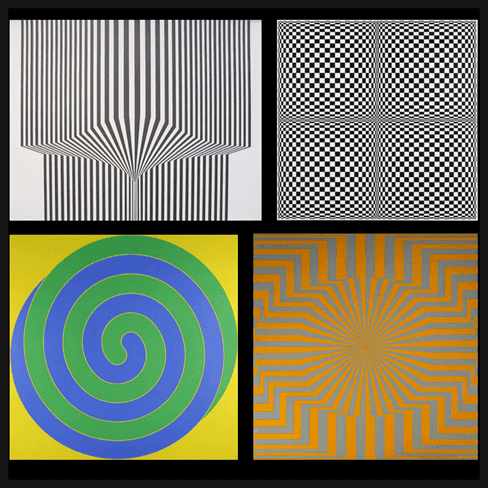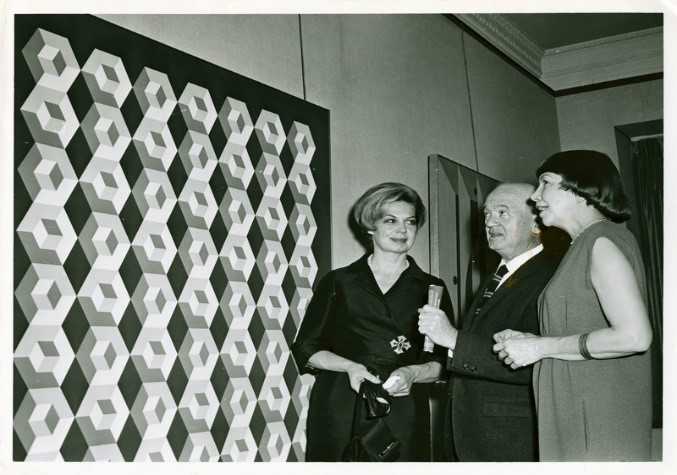
The queen of Op Art, Edna Andrade (1917-2008)
Destined for Design
Edna knew from a very early age that art and design was her life’s passion. Born in Portsmouth, Virginia in 1917, Edna Wright was introduced to structure and design as a young girl watching her civil engineer father design bridges and complex structures.
After graduating from high school, Edna moved to Philadelphia and attended the Pennsylvania Academy of Fine Arts. She earned a scholarship to study art in Europe, where she was first exposed to the German Bauhaus movement as well as a number of post-World War I expressionist painters that influenced her artistic approach.
Edna returned to Philadelphia in 1938 to complete her post-graduate studies and married architect C. Preston Andrade. Her life would always revolve around art and study, but she never imagined the interesting detour that her career path would soon take.
OSS Recruits Visual Artists
When the United States entered World War II, Edna’s husband accepted a position with the Navy’s Bureau of Aeronautics, and they moved to Washington, D.C. Edna wanted to do her part to help the war effort too. Through her connections in the art world, she learned that General William Donovan was looking for “creative types” to work in the Office of Strategic Services (OSS), CIA’s predecessor organization.
Edna put her skills to good use in the OSS. She found herself in the company of an eclectic group of artists, which included graphic designer Georg Olden; graphic designer/architect Donal McLaughlin, who helped design the UN emblem; cartoonist Sam Berman; painter Auriel Bessemer; and sci-fi author Groff Conklin. The team was led by Finnish-American architect, Eero Saarinen, who served the spy agency before achieving world-wide fame for his neo-futuristic style.
OSS artists and designers mostly worked shoulder-to-shoulder within a large windowless auditorium that resembled a New York City art studio more than a D.C. government office. They created everything from propaganda posters, military orientation films, training manuals, maps, to three-dimensional organization charts and models that the War Department used in various conference rooms. Edna’s OSS work showed the bold designs that would become her hallmark.

Edna Andrade in the 1960s
Finding Her Own Voice in the Op Art Movement
After the OSS, Edna worked for different architecture firms as a drafting assistant. She then decided to quit the private sector because she found the work stifling and unfulfilling and returned to the Philadelphia College of Art to teach.
During the 1960s, Edna and Preston Andrade divorced. Edna channeled all she had learned from the OSS and the fields of art and architecture and finally experienced her artistic breakthrough. She created works of art that were highly precise with geometrically intricate shapes and designs in bold, contrasting colors, conveying a sense of motion.
Her style of painting often produced hallucinatory psychedelic reactions—as if the shapes themselves were playing tricks on your eyes. Edna was at the forefront of a new art revolution, which the critics called Optical Art or “Op Art” for short. The international art movement came to prominence in the 1960s, exploring the ways that abstract pattern, color, and form can affect the eye.

Some of Edna’s Op Art works: Black Diamond. 1971 (Top Left). Color Motion. 1964 (Top Right). Earth Day. 1970 (Bottom Left). Radiant Ellipse. 1965. (Bottom Right)
For the next forty years, Edna would produce an impressive collection of creative paintings and murals, though her artwork became more popular in her later years. Edna lived in her beloved Philadelphia for the rest of her life, dividing her time between art and teaching. When she passed away in 2008 at the age of 91, the art community recognized her as a major driver of the Op Art movement. Her art is on display in museums across the country and around the world.

Edna Andrade (Right) discussing her work, “Hot Blocks” in 1967
Visual Artists and Designers in Today’s CIA
To this day, CIA needs talented visual artists like Edna to secure the Nation’s defense. CIA’s visual artists and creative technologists communicate through storytelling and art to help officers and stakeholders understand complex information. They create interactive displays, virtual or extended reality tools, maps, and infographics. They work with technicians and scientists to help design and develop advanced technologies. Here are some of the current roles CIA has for artists and designers:
- Graphic Designer
- Cartographer
- Editor/Publications Officer
- Electronic Publishing Specialist (Visual Media Designer)
- Interactive Designer
- Technical Operations Officer
- Undergraduate Internship/Co-Op Program-Cartographer, Editor, Graphic or Interactive Designer
- Undergraduate Internship/Co-op Program-Graphic Designer
